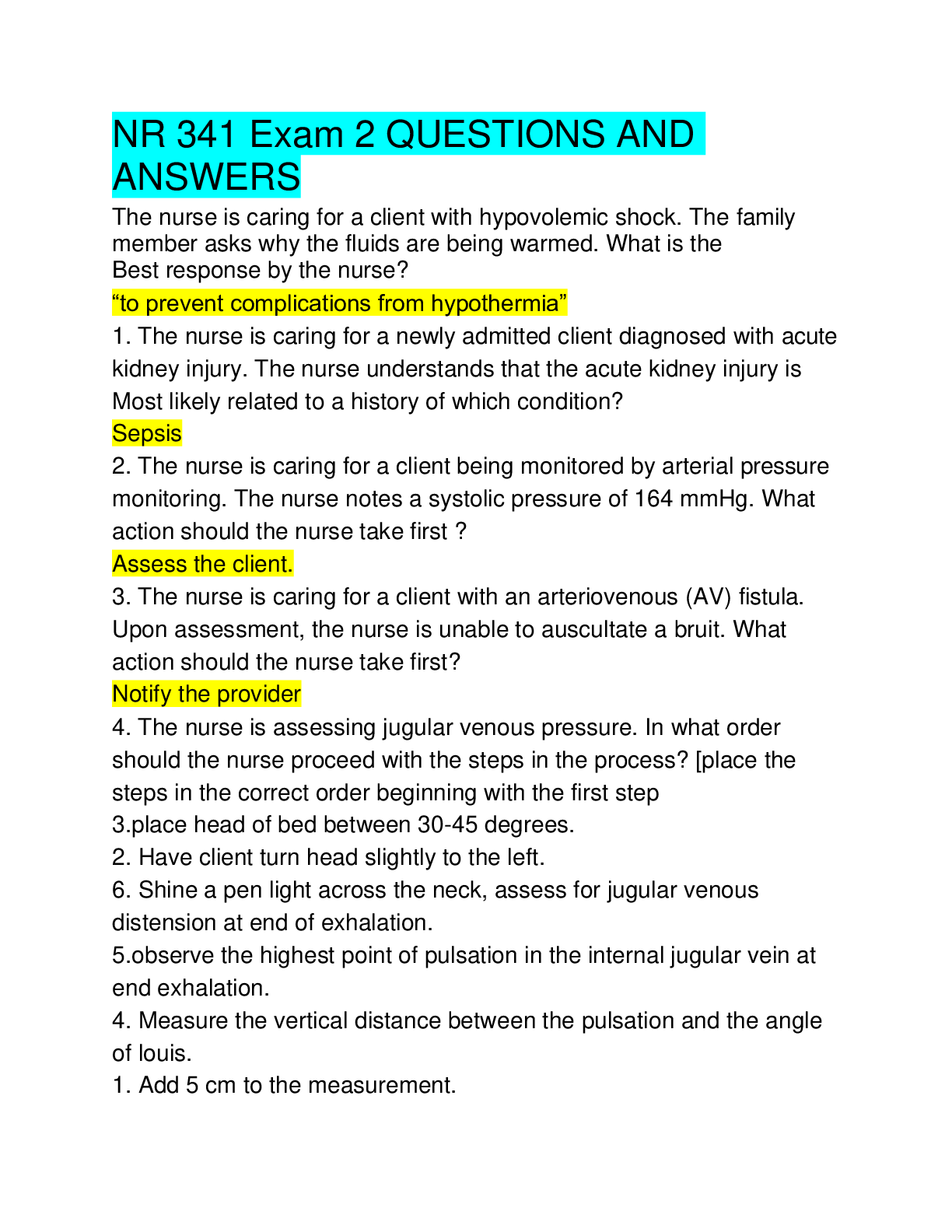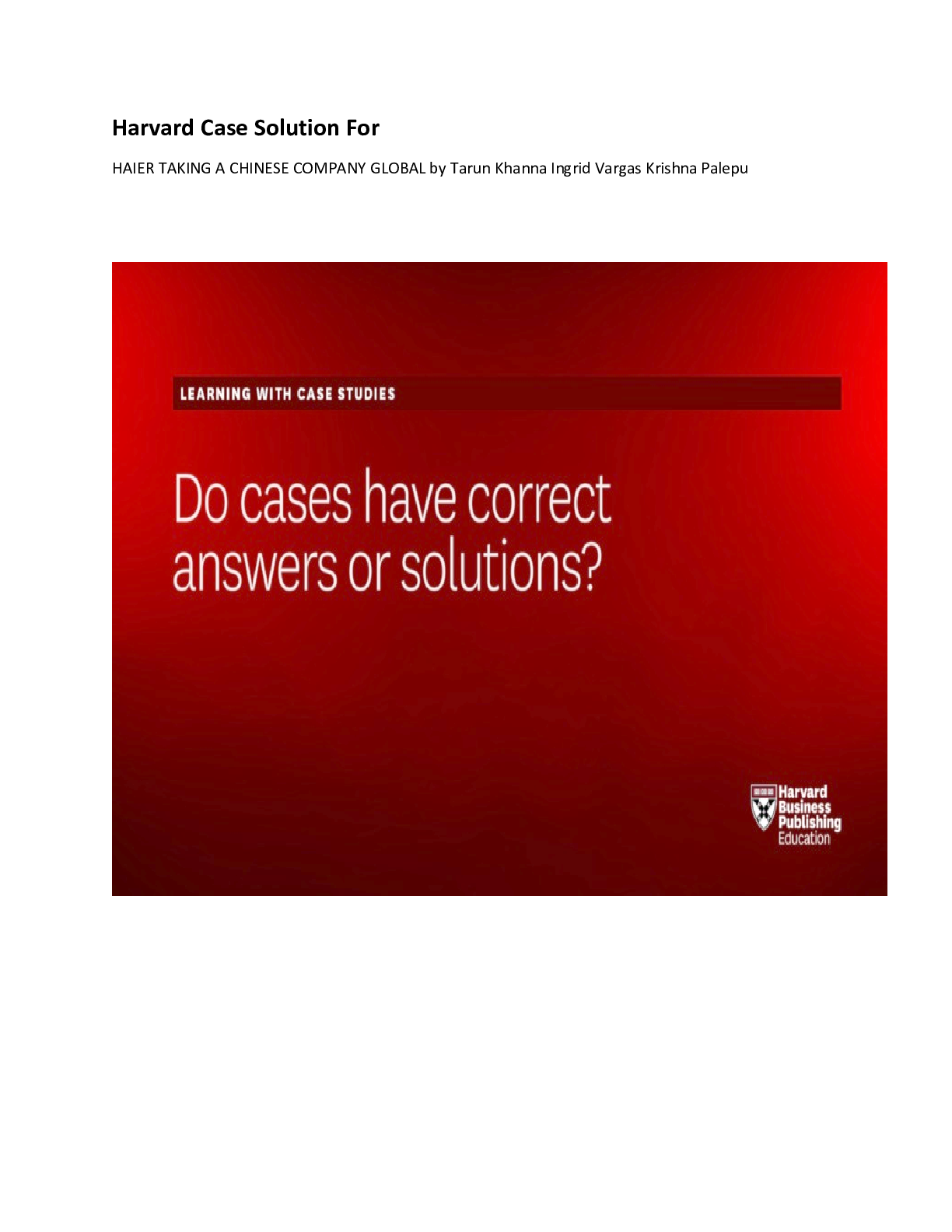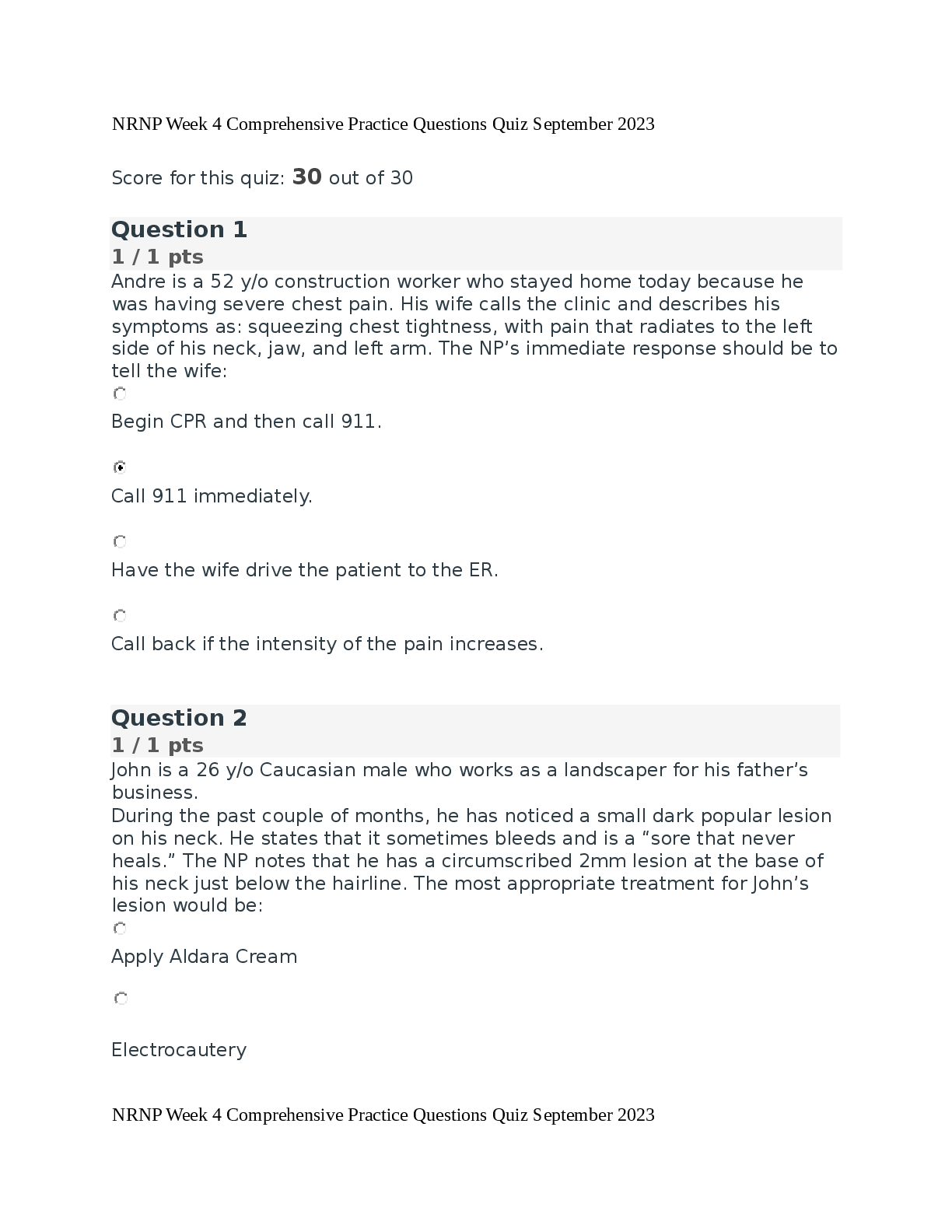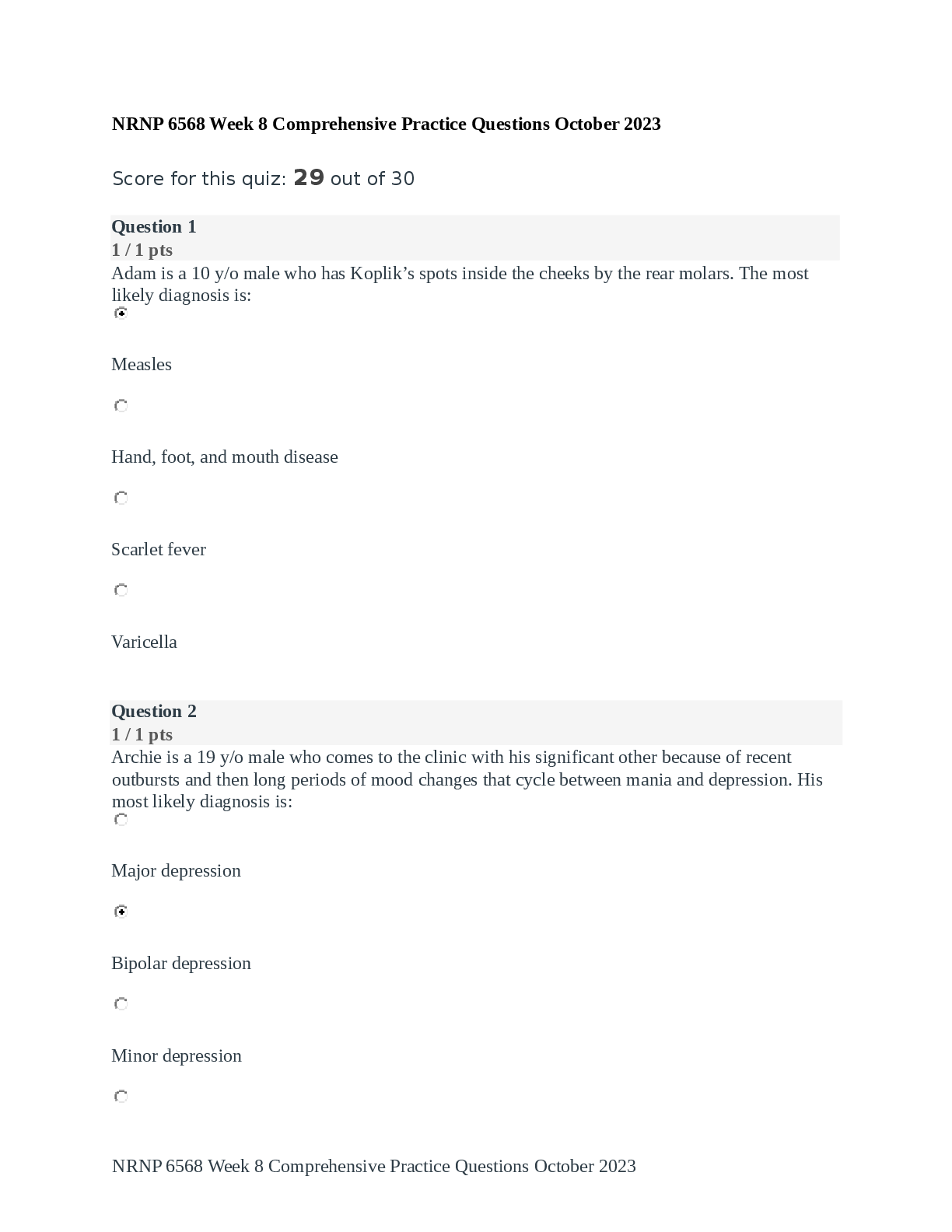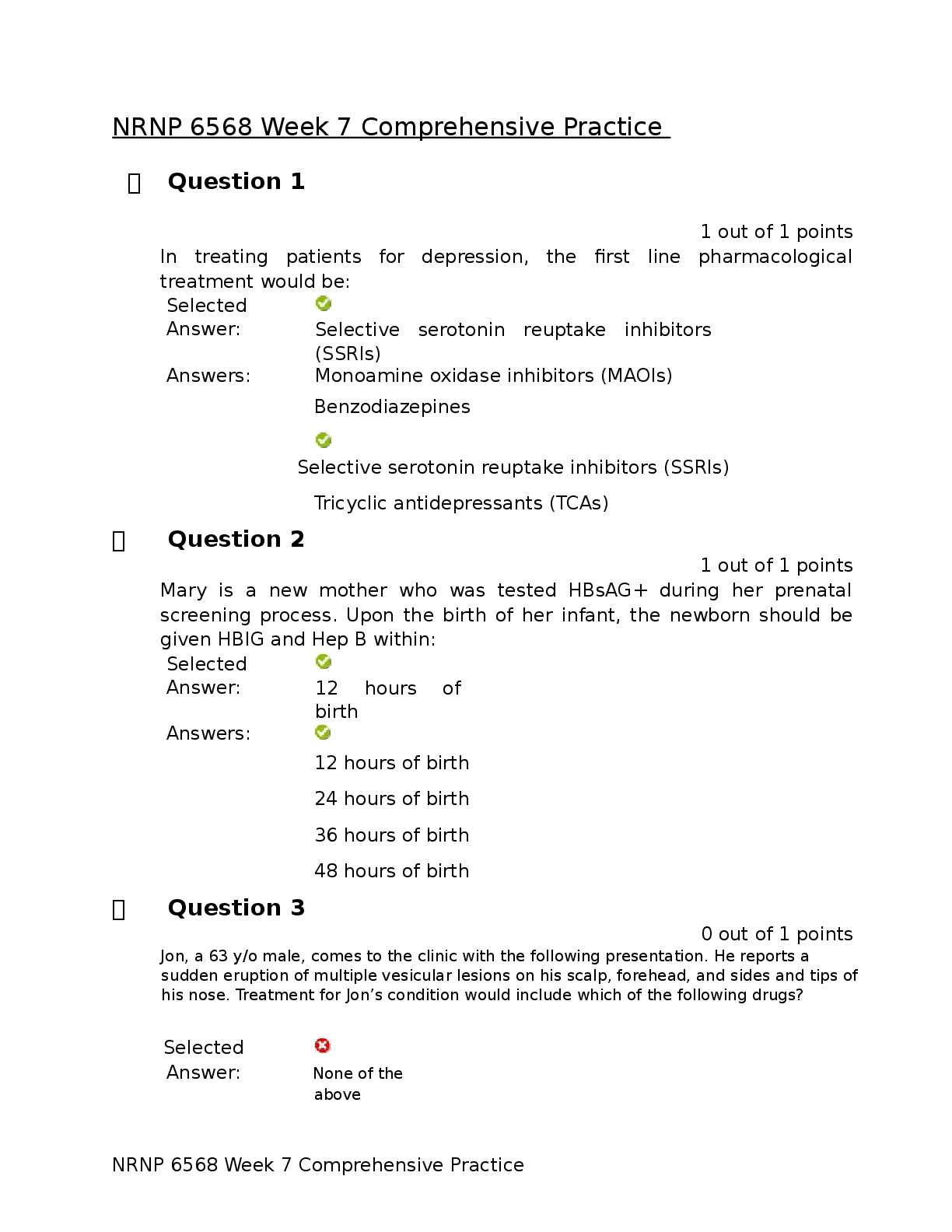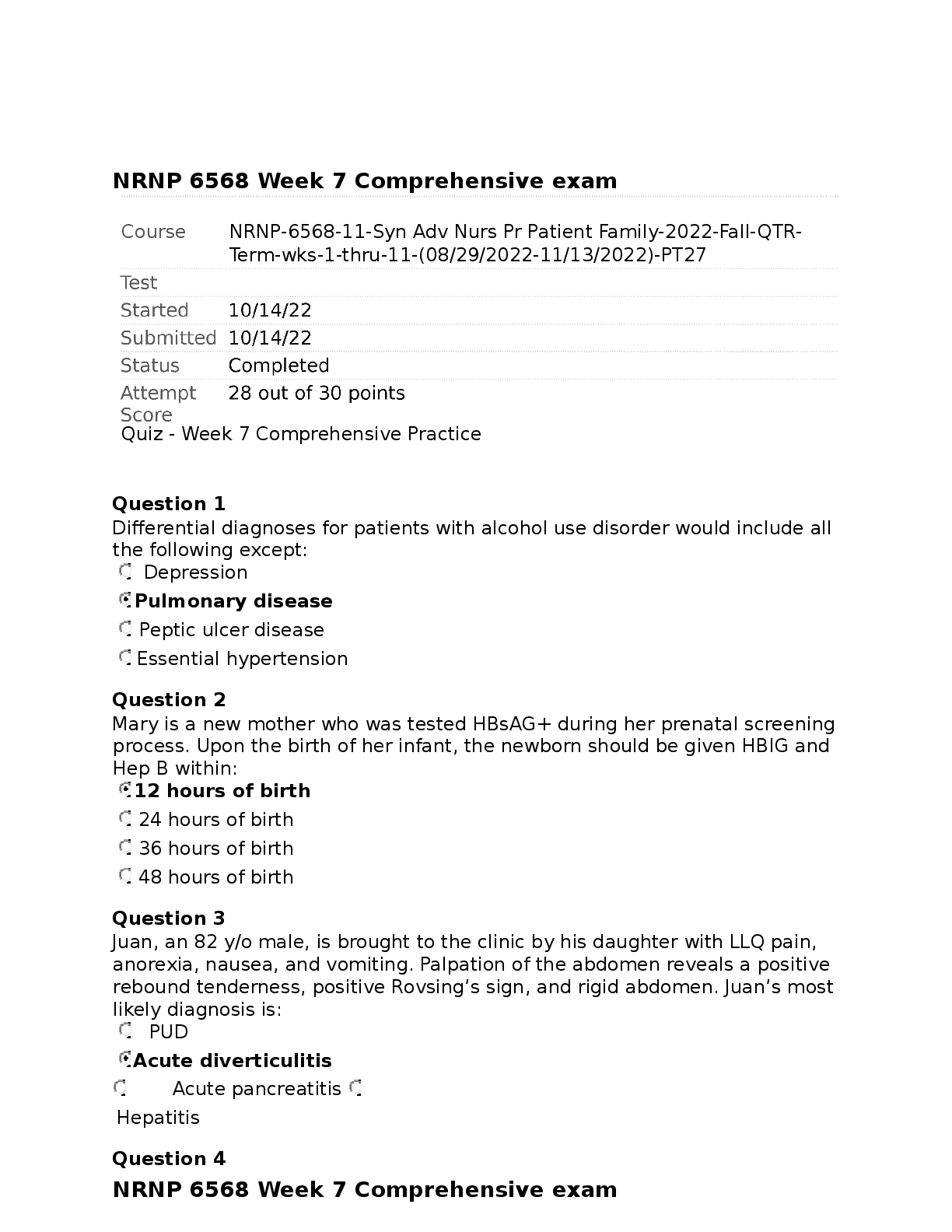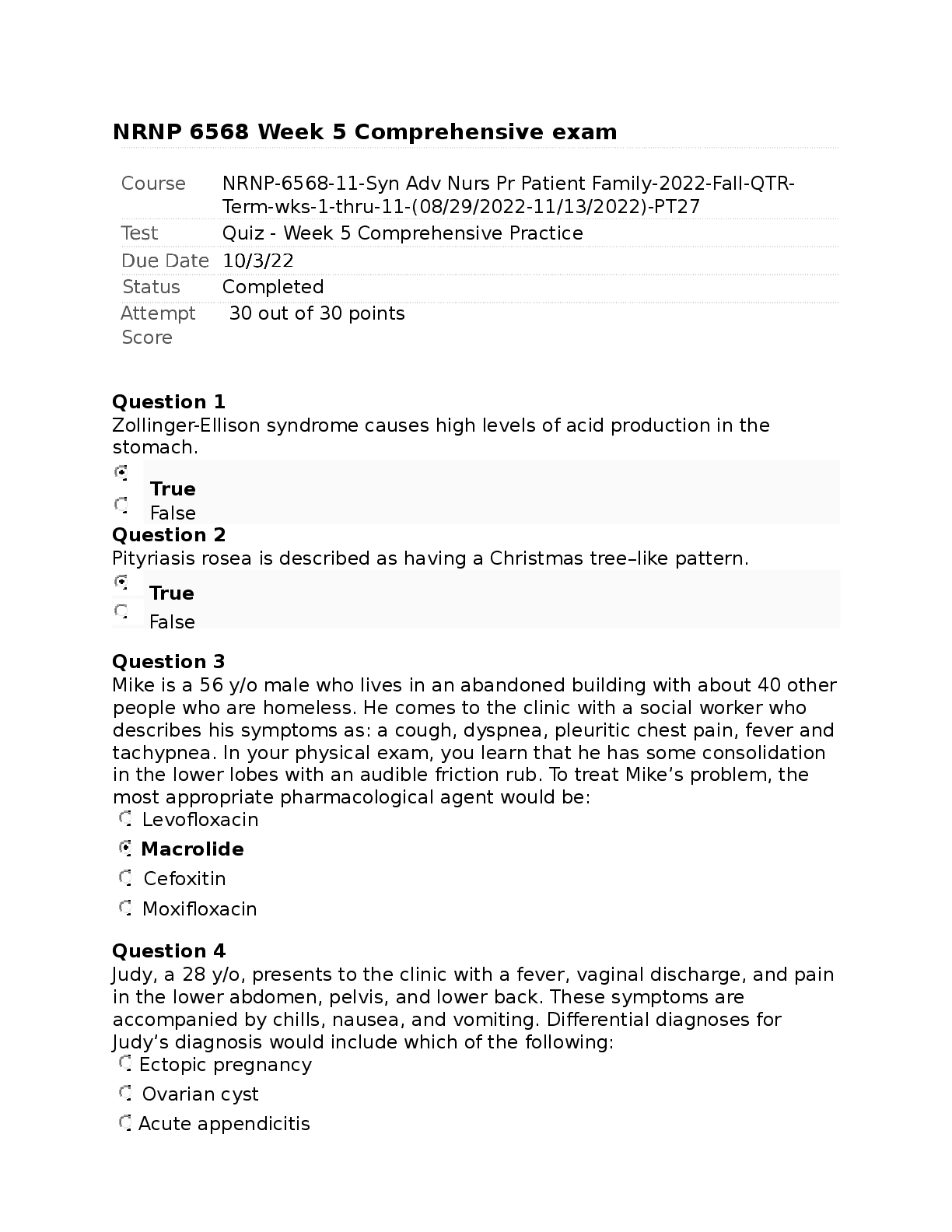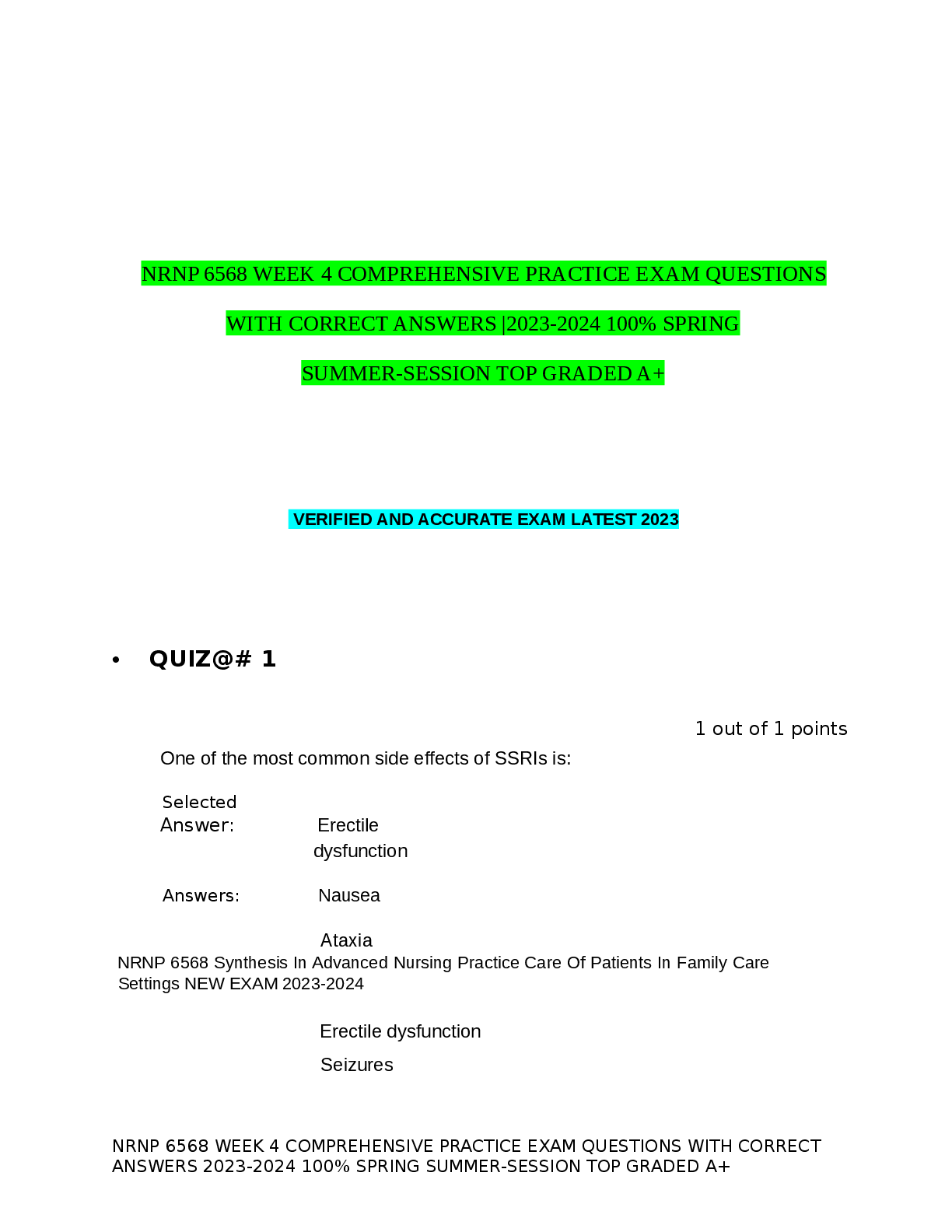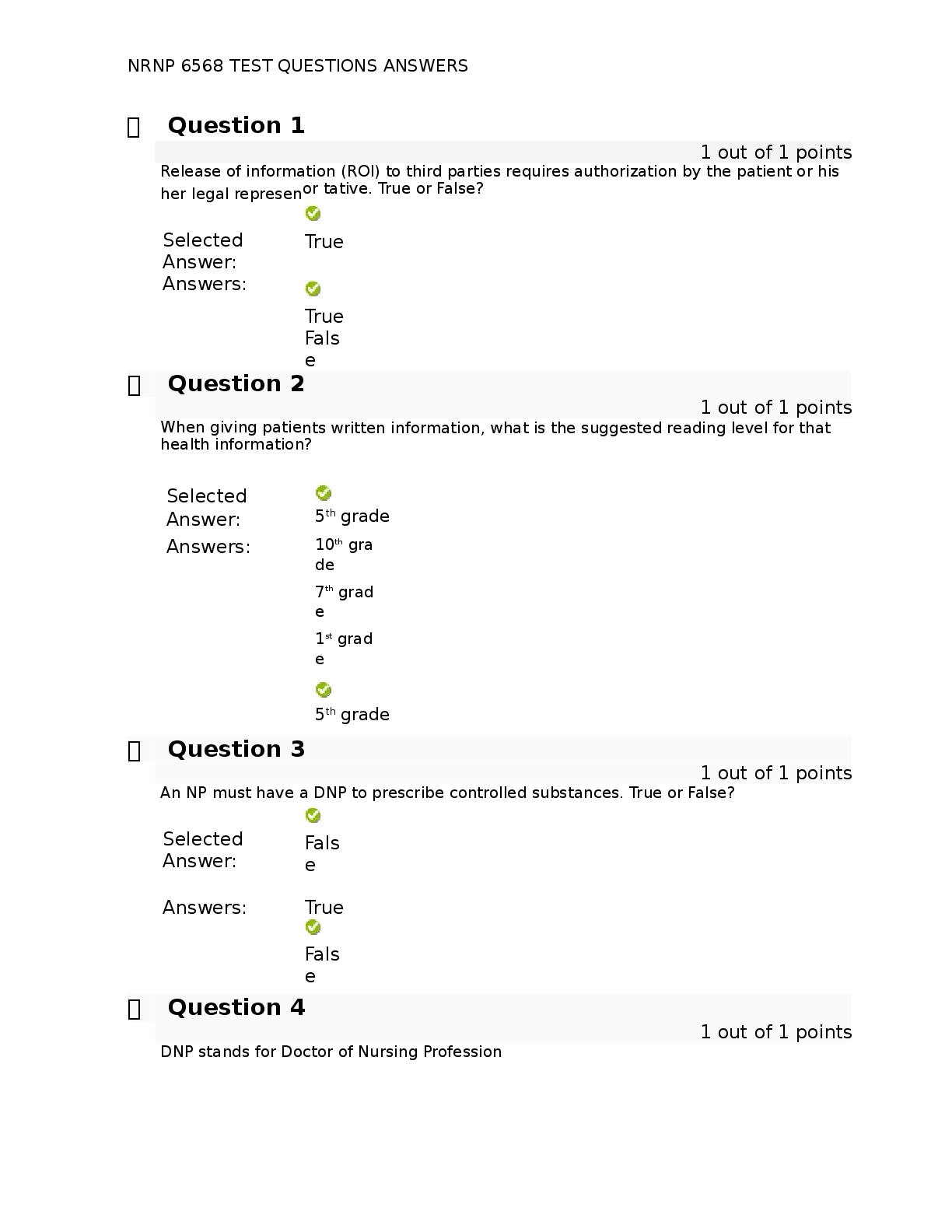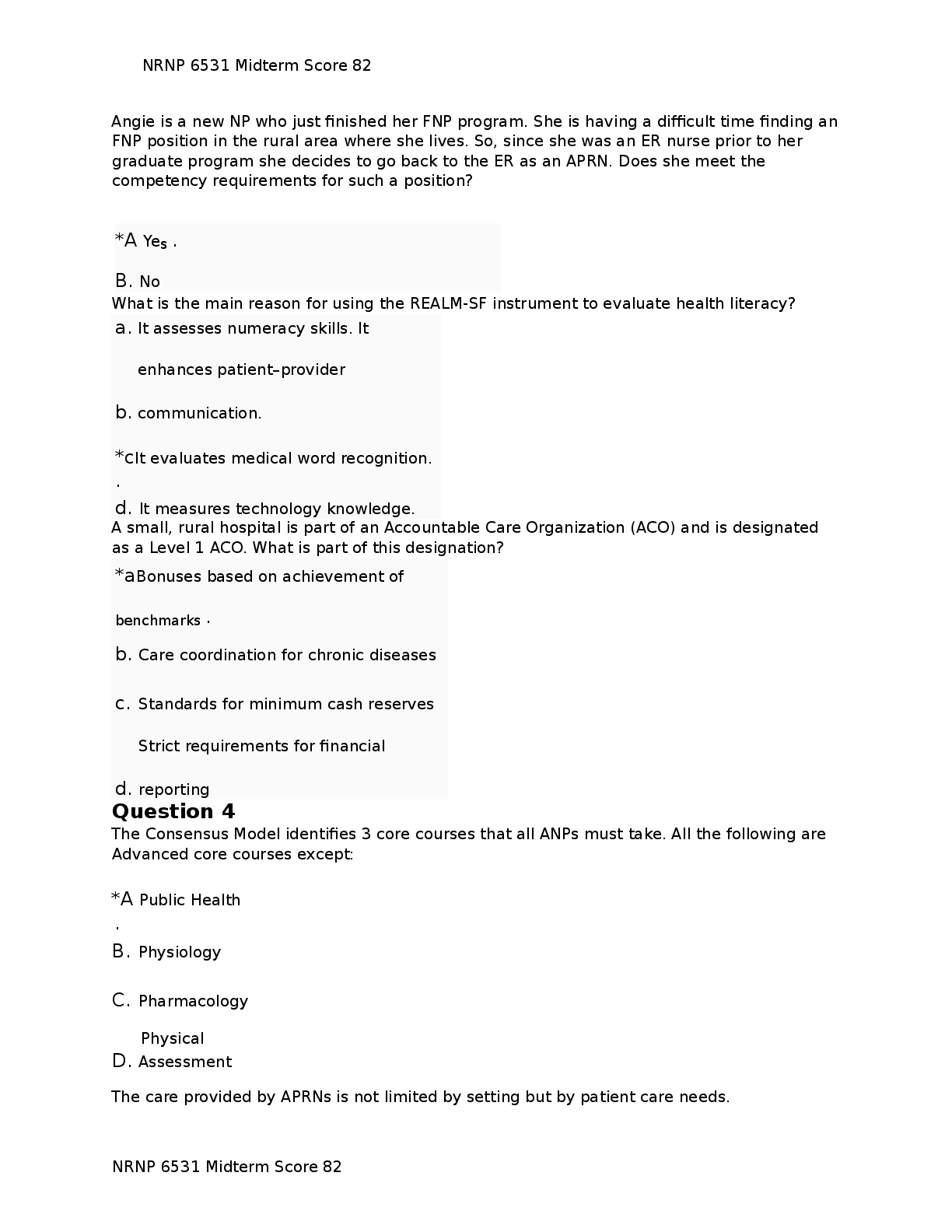Management > EXAMs > MGT 420 FINAL EXAM 2 | GRADED A (All)
MGT 420 FINAL EXAM 2 | GRADED A
Document Content and Description Below
MGT 420 FINAL EXAM 2 1) __________ refers to the propensity for a product to perform consistently over its useful life. A. Conformance B. Serviceability C. Reliability D. Durability E. Perceive ... d quality 2) Like engineers, operations managers are very concerned about product & process design. However, rather than focusing on only the technical aspects of those activities, operations concentrates on the __________ of these activities. A. Economics B. Marketing C. Staffing D. Financing E. Management 3) __________ refers to the efficiency with which a product achieves its intended purpose. A. Performance B. Serviceability C. Conformance D. Features E. Reliability 4) Which type of power is derived from the possession of special knowledge (or the assumption that a person has special knowledge)? A. Power of expertise B. Legitimate power C. Referent power D. Reward power E. Coercive power 5) __________ is the process by which a leader influences a group to move toward the attainment of superordinate goals. A. Leadership B. Controlling C. Organizing D. Empowerment E. Planning 6) __________ goals are those goals that pertain to achieving a higher end that benefits not just the individual, but the group. A. Substantive B. Hierarchical C. Superordinate D. Deterministic E. Empowerment-related 7) __________ is concerned with monitoring process capability & process stability. A. Reengineering B. Life testing C. Concurrent engineering D. Statistical process control E. Redundancy testing 8) Business cases, process mapping, voice of the customer, change management, & problem/objective statements are used in the ______ Six Sigma process. A. defining B. controlling C. improving D. measuring E. analyzing 9) A firm’s understanding of the customers, their needs, & their wants is referred to as: A. customer culture B. closeness to customers C. cultural richness D. customer conformance E. internal customer perspective 10) The three aspects of Juran’s trilogy are: A. planning, control, & improvement B. leadership, cost, & quality C. organizing, management, & control D. cost, quality, & customer satisfaction E. labor, management, & systems 11) The development & dissemination of the basic seven tools of quality was the work of: A. Kaoru Ishikawa B. W. Edwards Deming C. Joseph Juran D. Genichi Taguchi E. Philip Crosby 12) Feigenbaum’s primary contribution to quality thinking in America was his assertion that: A. the entire organization should be involved in improving quality B. quality problems are largely the result of ineffective implementation C. quality equals profitability D. quality problems are largely the result of insufficient & ineffective planning E. quality is free 13) The model of reactive customer-driven quality shows: A. a firm’s quality performance is increasing while quality costs are also increasing B. a firm’s quality performance is decreasing while customer’s expectations are also decreasing C. a firm’s quality performance is increasing while customer’s expectations are decreasing D. a firm’s quality performance is increasing while quality costs are decreasing E. a firm’s quality performance is increasing while customer’s expectations are also increasing 14) Process design in services has traditionally focused on the: A. transaction B. exchange C. follow-up D. acquisition E. completion 15) The view of the customer that asserts that he or she is a valued asset to be managed is referred to as: A. opinion of the end user B. voice of the customer C. customer relationship management D. house of quality E. cry of the customer 16) Your author indicates that although statistical inspection is an important approach to improving quality, it is inherently: A. wrong B. difficult C. philosophical D. reactive E. evil 17) Quality experts agree that quality can be assured only during the: A. production phase B. installation & testing procedure C. design phase D. sales process E. marketing campaign 18) The core of quality management variables contains: A. leadership B. information analysis C. strategic planning D. team approach E. environmental characteristics 19) Strategic planning has two important dimensions. These are: A. analysis & synthesis B. proactive & standardized C. content & process D. strategic & routine E. implementation & control 20) Strategic planning implies planning for: A. the short term B. the long term C. the short term in manufacturing & the long term in services D. the intermediate term E. the short term in services & the long term in manufacturing 21) The ten determinants of service quality as determined by Parasuraman, Zeithamel, & Berry include responsiveness, which involves the willingness or readiness to provide service. This is demonstrated by: A. company name B. waiting time to receive service C. accuracy in billing D. company reputation E. calling the customer back quickly 22) The three spheres of quality are: A. quality planning & management, quality assurance, & quality control B. quality in products, quality in services, & quality in customer orientation C. quality in design, quality in manufacturing, & quality in customer service D. quality planning & management, quality conformance, & quality education E. internal quality, external quality & quality systems 23) _____________ approaches are required to achieve the desired results because quality is not under the purview of any specific group. A. Radical B. PDCA C. Cross-functional D. Traditional E. Normative 24) Hoshin planning or policy deployment provides a framework for achieving alignment through: A. enterprise resource planning B. electronic data interchange C. the catchball process D. benchmarking E. prototyping process 25) Which of the following is a description of the “categorizing” stage of the internal environmental analysis process? A. Generate long-lists of strengths & weaknesses from primary & support activities of the firm’s value chain B. Determine where, along the firm’s value chain, potential competitive advantage lies C. Look at each competitively relevant resources & capability relative to its potential as a cost or uniqueness driver D. Choose the appropriate generic strategy for the firm – cost leadership or differentiation E. Reconceptualize long-list in terms of resources & capabilities & complete deeper inspection with the application of key questions 26) The means of generating lists of strengths & weaknesses in the internal environmental analysis process is referred to as: A. surveying B. identifying C. synthesizing D. investigating E. scanning 27) The internal environmental analysis process is a four stage process that includes all of the following stages except: A. surveying B. consolidating C. investigating D. categorizing E. evaluating 28) A tool used by many firms to differentiate & discriminate among suppliers is called: A. provider appraisal B. provider assessment C. partner assessment D. supplier appraisal E. supplier evaluation 29) A term used to characterize the relationship between suppliers & customers when a high degree of linkages & interdependencies exist is __________. . value partnering . supplier linking . supplier/customer codependence D. supplier partnering . customer partnering 30) External validation measures of quality programs such as the Baldrige criteria & ISO 001:2000 are referred to as: A. single-source measures . single-source filters . stretch validation measures . benchmarking measures . externally-directed filters 31) A system that aids customer & supplier communication by linking together supplier customer information systems is referred to as:A. Data interchange B. Electronically generated data transferC. Electronic data interchange D. CPU data interchangeE. Computer data transfer 32) External validation measures of quality programs such as the Baldrige criteria & ISO 9001:2000 are referred to as: A. benchmarking measures B. stretch validation measures C. externally-directed filters D. single-source filters E. single-source measures 33) Single sourcing: A. has no effect on the number of suppliers a firm uses B. increases the number of suppliers a firm uses in services industries but decreases the number of suppliers a firm uses in manufacturing C. increases the number of suppliers a firms uses in manufacturing but decreases the number of suppliers a firm uses in services D. increases the number of suppliers a firm uses E. decreases the number of suppliers a firm uses 34) Many companies perform lengthy inspections of their suppliers that involve long- term visits & evaluations. There programs are often called: A. supplier certification programs B. supplier compliance programs C. supplier confirmation programs D. supplier affirmation programs E. supplier requirement programs 35) From a quality perspective, an interesting variation of the value chain is the concept of the: A. string of value B. progression of value C. sequence of value D. sequence of patrons E. chain of customers 36) Which of the following is not one of the support activities in the value chain? A. Firm infrastructure B. Marketing & sales C. Technology development D. Procurement E. Human resource management 37) Which Baldrige criterion requires the applicant to outline what his or her firm is doing in the area of corporate citizenship? A. Customer & market focus B. Leadership C. Process management D. Business results E. Strategic planning 38) The goals of QS 9000 is to: A. find a company that is superior in a particular area, study what is does, & gather ideas for improving your own operation in that area B. enhance quality systems for suppliers while eliminating redundant requirements & reducing costs C. integrate financial, planning, & control systems into a single architecture D. keep American families safe by reducing the risk of injury or death from consumer products E. identify & prioritize problems that need to be solved 39) How many winners of the MBNQA can there be each year? A. 8 B. 4 C. 3 D. 6 E. 1 40) Which Baldrige criteria is used to evaluate the extent to which top management is personally involved in creating & reinforcing goals, values, directions, & customer involvement? . Information & analysis . Strategic planning . Leadership . Human resource focus . Process management 41) Which Baldrige criterion focuses on how a firm assesses the relative importance of roduct or service functions? A. strategic planning . customer & market focus . process management . leadership . information & analysis 42) Which Baldrige criteria focuses on how the company establishes strategic direction, how it sets its tactical action plans to implement the strategic plan.A. process managementB. customer & market focus C. strategic lanning D. informatio & analysis E. leadership [Show More]
Last updated: 3 years ago
Preview 1 out of 8 pages

Buy this document to get the full access instantly
Instant Download Access after purchase
Buy NowInstant download
We Accept:

Reviews( 0 )
$12.00
Can't find what you want? Try our AI powered Search
Document information
Connected school, study & course
About the document
Uploaded On
Feb 16, 2021
Number of pages
8
Written in
All
Additional information
This document has been written for:
Uploaded
Feb 16, 2021
Downloads
0
Views
113


